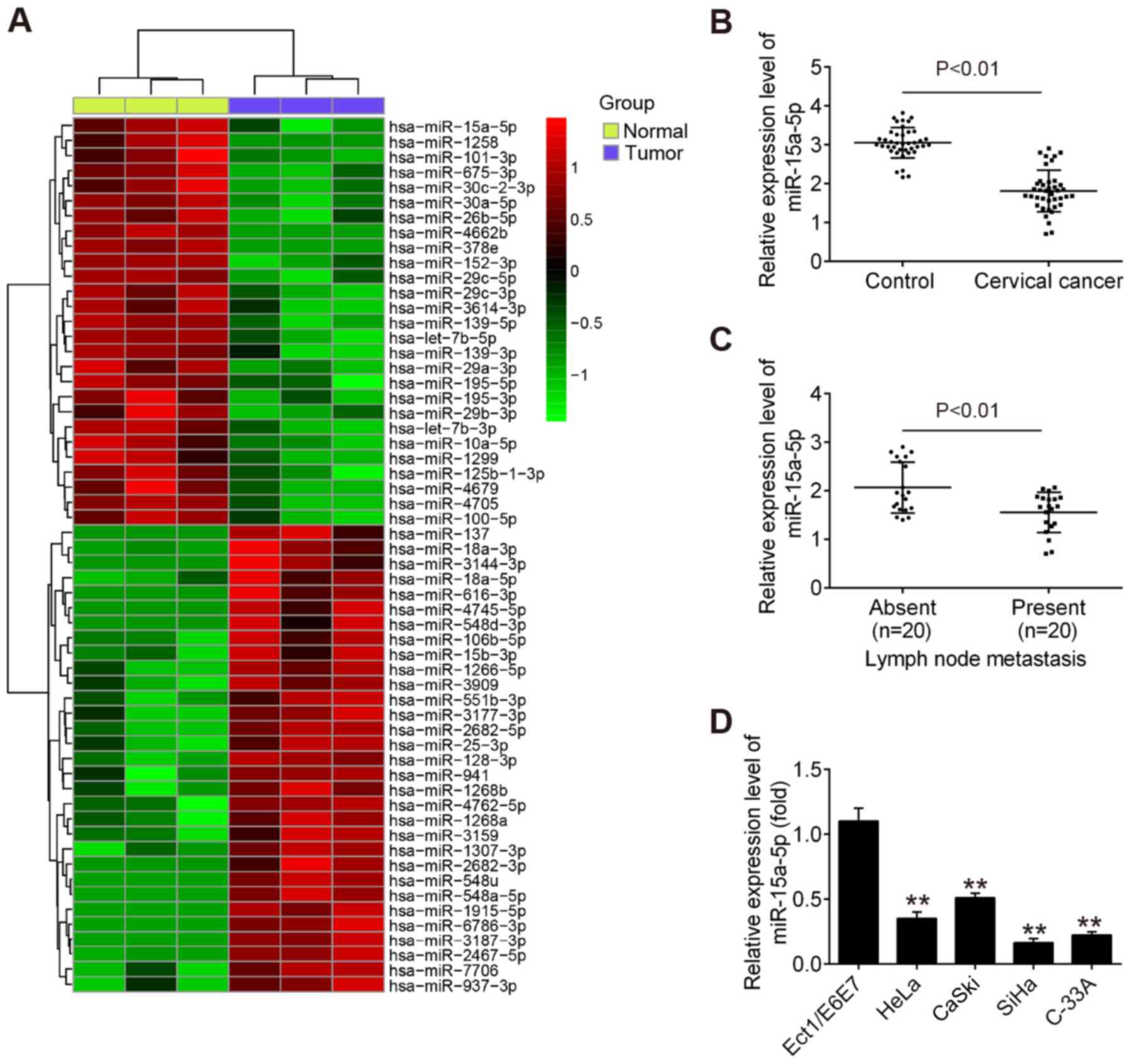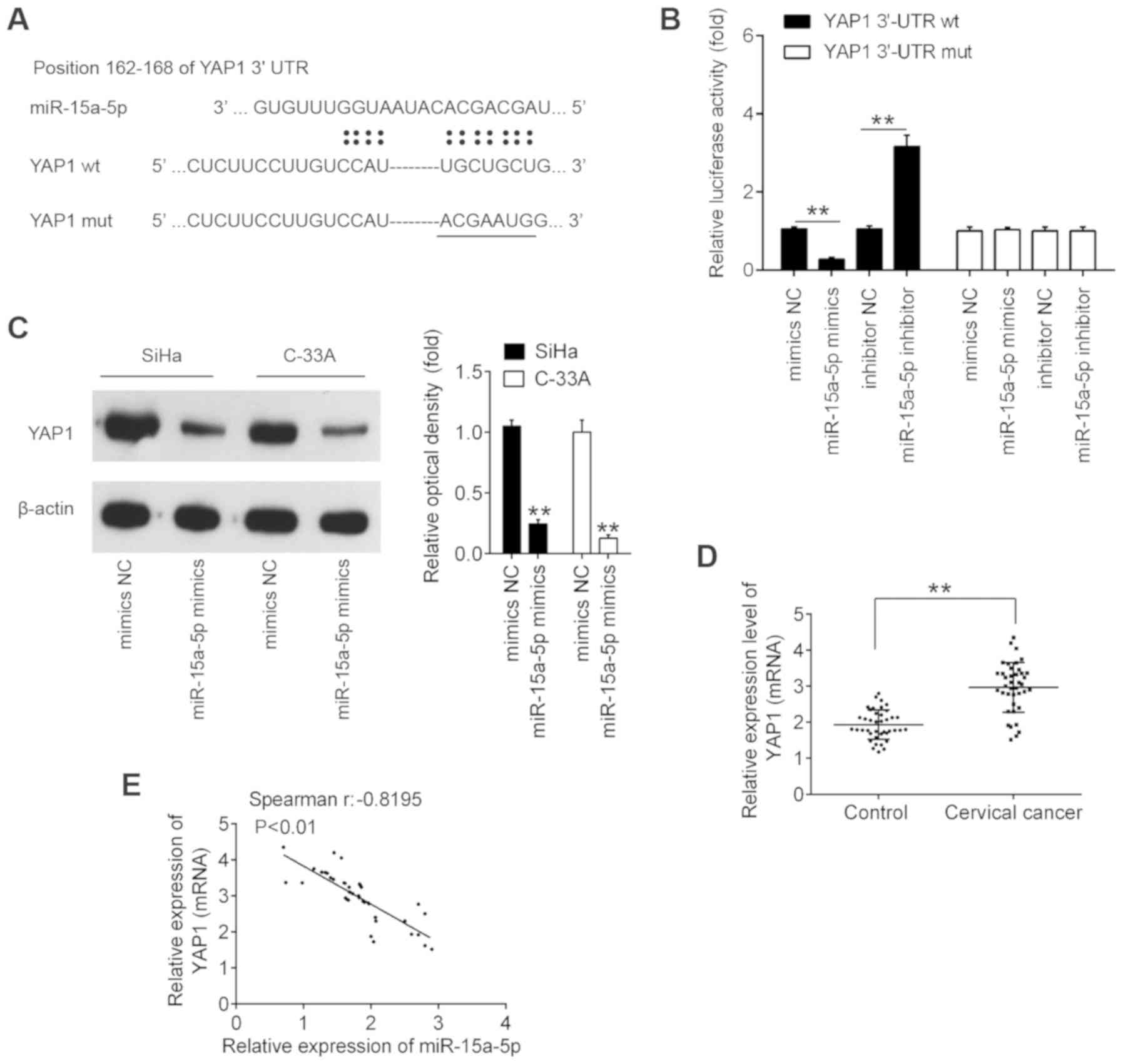|
1
|
Alldredge JK and Tewari KS: Clinical
trials of antiangiogenesis therapy in recurrent/persistent and
metastatic cervical cancer. oncologist. 21:576–585. 2016.
View Article : Google Scholar : PubMed/NCBI
|
|
2
|
Tsikouras P, Zervoudis S, Manav B, Tomara
E, Iatrakis G, Romanidis C, Bothou A and Galazios G: Cervical
cancer: Screening, diagnosis and staging. J BUON. 21:320–325.
2016.PubMed/NCBI
|
|
3
|
Fang J, Zhang H and Jin S: Epigenetics and
cervical cancer: From pathogenesis to therapy. Tumour Biol.
35:5083–5093. 2014. View Article : Google Scholar : PubMed/NCBI
|
|
4
|
Wang J, Liu Y, Wang X, Li J, We J, Wang Y,
Song W and Zhang Z: MiR-1266 promotes cell proliferation, migration
and invasion in cervical cancer by targeting DAB2IP. Biochim
Biophys Acta Mol Basis Dis. 1864:3623–3630. 2018. View Article : Google Scholar : PubMed/NCBI
|
|
5
|
Zhu L, Zhu L, Shi H, Wang H, Yan J, Liu B,
Chen W, He J, Zhou Z, Yang X and Liu T: Evaluating early response
of cervical cancer under concurrent chemo-radiotherapy by
intravoxel incoherent motion MR imaging. BMC Cancer. 16:792016.
View Article : Google Scholar : PubMed/NCBI
|
|
6
|
Li T and Cho WC: MicroRNAs: Mechanisms,
functions and progress. Genomics Proteomics Bioinformatics.
10:237–238. 2012. View Article : Google Scholar : PubMed/NCBI
|
|
7
|
Shukla GC, Singh J and Barik S: MicroRNAs:
Processing, Maturation, target recognition and regulatory
functions. Mol Cell Pharmacol. 3:83–92. 2011.PubMed/NCBI
|
|
8
|
Zhu H, Xie R, Liu X, Shou J, Gu W, Gu S
and Che X: MicroRNA-494 improves functional recovery and inhibits
apoptosis by modulating PTEN/AKT/mTOR pathway in rats after spinal
cord injury. Biomed Pharmacother. 92:879–887. 2017. View Article : Google Scholar : PubMed/NCBI
|
|
9
|
Zhu Y, Wu G, Yan W, Zhan H and Sun P:
miR-146b-5p regulates cell growth, invasion, and metabolism by
targeting PDHB in colorectal cancer. Am J Cancer Res. 7:1136–1150.
2017.PubMed/NCBI
|
|
10
|
Li JH, Zhang Z, Du MZ, Guan YC, Yao JN, Yu
HY, Wang BJ, Wang XL, Wu SL and Li Z: microRNA-141-3p fosters the
growth, invasion, and tumorigenesis of cervical cancer cells by
targeting FOXA2. Arch Biochem Biophys. 657:23–30. 2018. View Article : Google Scholar : PubMed/NCBI
|
|
11
|
Xia P, Gao X, Duan L, Zhang W and Sun YF:
Mulberrin (Mul) reduces spinal cord injury (SCI)-induced apoptosis,
inflammation and oxidative stress in rats via miroRNA-337 by
targeting Nrf-2. Biomed Pharmacother. 107:1480–1487. 2018.
View Article : Google Scholar : PubMed/NCBI
|
|
12
|
Yang Y, Liu Y, Li G, Li L, Geng P and Song
H: microRNA-214 suppresses the growth of cervical cancer cells by
targeting EZH2. Oncol Lett. 16:5679–5686. 2018.PubMed/NCBI
|
|
13
|
Dong J, Wang M, Ni D, Zhang L, Wang W, Cui
X, Fu S and Yao S: MicroRNA-217 functions as a tumor suppressor in
cervical cancer cells through targeting Rho-associated protein
kinase 1. Oncol Lett. 16:5535–5542. 2018.PubMed/NCBI
|
|
14
|
Chen Y, Song Y, Mi Y, Jin H, Cao J, Li H,
Han L, Huang T, Zhang X, Ren S, et al: microRNA-499a promotes the
progression and chemoresistance of cervical cancer cells by
targeting SOX6. Apoptosis. 25:205–216. 2020. View Article : Google Scholar : PubMed/NCBI
|
|
15
|
Yang D and Zhang Q: miR-152 may function
as an early diagnostic and prognostic biomarker in patients with
cervical intraepithelial neoplasia and patients with cervical
cancer. Oncol Lett. 17:5693–5698. 2019.PubMed/NCBI
|
|
16
|
Guo Y, Ma D, Jia SF, Liu J, Fan SB, Zhang
M, Shi LR, Jiang LL, Shi JX, Wang HQ, et al: Proliferation of
MicroRNA-365 and E74-like factor 4 in cervical cancer cells and its
clinical significance. Zhongguo Yi Xue Ke Xue Yuan Xue Bao.
41:220–227. 2019.PubMed/NCBI
|
|
17
|
Mei LL, Wang WJ, Qiu YT, Xie XF, Bai J and
Shi ZZ: miR-125b-5p functions as a tumor suppressor gene partially
by regulating HMGA2 in esophageal squamous cell carcinoma. PLoS
One. 12:e01856362017. View Article : Google Scholar : PubMed/NCBI
|
|
18
|
Livak KJ and Schmittgen TD: Analysis of
relative gene expression data using real-time quantitative PCR and
the 2(-Delta Delta C(T)) method. Methods. 25:402–408. 2001.
View Article : Google Scholar
|
|
19
|
Zhang MY, Lin J and Kui YC: MicroRNA-345
suppresses cell invasion and migration in non-small cell lung
cancer by directly targeting YAP1. Eur Rev Med Pharmacol Sci.
23:2436–2443. 2019.PubMed/NCBI
|
|
20
|
Wang ZM, Wan XH, Sang GY, Zhao JD, Zhu QY
and Wang DM: miR-15a-5p suppresses endometrial cancer cell growth
via Wnt/β-catenin signaling pathway by inhibiting WNT3A. Eur Rev
Med Pharmacol Sci. 21:4810–4818. 2017.PubMed/NCBI
|
|
21
|
Chen D, Wu D, Shao K, Ye B, Huang J and
Gao Y: MiR-15a-5p negatively regulates cell survival and metastasis
by targeting CXCL10 in chronic myeloid leukemia. Am J Transl Res.
9:4308–4316. 2017.PubMed/NCBI
|
|
22
|
Huang X, Tang F, Weng Z, Zhou M and Zhang
Q: MiR-591 functions as tumor suppressor in breast cancer by
targeting TCF4 and inhibits Hippo-YAP/TAZ signaling pathway. Cancer
Cell Int. 19:1082019. View Article : Google Scholar : PubMed/NCBI
|
|
23
|
Zender L, Spector MS, Xue W, Flemming P,
Cordon-Cardo C, Silke J, Fan ST, Luk JM, Wigler M, Hannon GJ, et
al: Identification and validation of oncogenes in liver cancer
using an integrative oncogenomic approach. Cell. 125:1253–1267.
2006. View Article : Google Scholar : PubMed/NCBI
|
|
24
|
Laengsri V, Kerdpin U, Plabplueng C,
Treeratanapiboon L and Nuchnoi P, Treeratanapiboon L and Nuchnoi P:
Cervical cancer markers: Epigenetics and microRNAs. Lab Med.
49:97–111. 2018. View Article : Google Scholar : PubMed/NCBI
|
|
25
|
Satapathy S, Batra J, Jeet V, Thompson EW
and Punyadeera C: MicroRNAs in HPV associated cancers: Small
players with big consequences. Expert Rev Mol Diagn. 17:711–722.
2017. View Article : Google Scholar : PubMed/NCBI
|
|
26
|
Xia N, Tan WF, Peng QZ and Cai HN:
MiR-374b reduces cell proliferation and cell invasion of cervical
cancer through regulating FOXM1. Eur Rev Med Pharmacol Sci.
23:513–521. 2019.PubMed/NCBI
|
|
27
|
Yao R, Zheng H, Wu L and Cai P: miRNA-641
inhibits the proliferation, migration, and invasion and induces
apoptosis of cervical cancer cells by directly targeting ZEB1. Onco
Targets Ther. 11:8965–8976. 2018. View Article : Google Scholar :
|
|
28
|
Xu Y, He Q, Lu Y, Tao F, Zhao L and Ou R:
MicroRNA-218-5p inhibits cell growth and metastasis in cervical
cancer via LYN/NF-κB signaling pathway. Cancer Cell Int.
18:1982018. View Article : Google Scholar
|
|
29
|
Yuan M, Zhao S, Chen R, Wang G, Bie Y, Wu
Q and Cheng J: MicroRNA-138 inhibits tumor growth and enhances
chemosensitivity in human cervical cancer by targeting H2AX. Exp
Ther Med. 19:630–638. 2020.
|
|
30
|
Ergun S, Güney S, Temiz E, Petrovic N and
Gunes S: Significance of miR-15a-5p and CNKSR3 as novel prognostic
biomarkers in non-small cell lung cancer. Anticancer Agents Med
Chem. 18:1695–1701. 2018. View Article : Google Scholar : PubMed/NCBI
|
|
31
|
Gao D, Zhang Y, Zhu M, Liu S and Wang X:
miRNA expression profiles of HPV-infected patients with cervical
cancer in the uyghur population in China. PLoS One.
11:e01647012016. View Article : Google Scholar : PubMed/NCBI
|
|
32
|
Miao H, Wang N, Shi LX, Wang Z and Song
WB: Overexpression of mircoRNA-137 inhibits cervical cancer cell
invasion, migration and epithelial-mesenchymal transition by
suppressing the TGF-β/smad pathway via binding to GREM1. Cancer
Cell Int. 19:1472019. View Article : Google Scholar
|
|
33
|
Wu Y, Huang J, Xu H and Gong Z:
Over-expression of miR-15a-3p enhances the radiosensitivity of
cervical cancer by targeting tumor protein D52. Biomed
Pharmacother. 105:1325–1334. 2018. View Article : Google Scholar : PubMed/NCBI
|
|
34
|
Druz A, Chen YC, Guha R, Betenbaugh M,
Martin SE and Shiloach J: Large-scale screening identifies a novel
microRNA, miR-15a-3p which induces apoptosis in human cancer cell
lines. RNA Biol. 10:287–300. 2013. View Article : Google Scholar : PubMed/NCBI
|
|
35
|
He J: Knocking down MiR-15a expression
promotes the occur-rence and development and induces the EMT of
NSCLC cells in vitro. Saudi J Biol Sci. 24:1859–1865. 2017.
View Article : Google Scholar
|
|
36
|
Bonci D, Coppola V, Musumeci M, Addario A,
Giuffrida R, Memeo L, D'Urso L, Pagliuca A, Biffoni M, Labbaye C,
et al: The miR-15a-miR-16-1 cluster controls prostate cancer by
targeting multiple oncogenic activities. Nat Med. 14:1271–1277.
2008. View Article : Google Scholar : PubMed/NCBI
|
|
37
|
Luo Q, Li X, Li J, Kong X, Zhang J, Chen
L, Huang Y and Fang L: MiR-15a is underexpressed and inhibits the
cell cycle by targeting CCNE1 in breast cancer. Int J Oncol.
43:1212–1218. 2013. View Article : Google Scholar : PubMed/NCBI
|
|
38
|
Wu C, Zheng X, Li X, Fesler A, Hu W, Chen
L, Xu B, Wang Q, Tong A, Burke S, et al: Reduction of gastric
cancer proliferation and invasion by miR-15a mediated suppression
of Bmi-1 translation. Oncotarget. 7:14522–14536. 2016. View Article : Google Scholar : PubMed/NCBI
|
|
39
|
Guo S, Xu X, Tang Y, Zhang C, Li J, Ouyang
Y, Ju J, Bie P and Wang H: miR-15a inhibits cell proliferation and
epithelial to mesenchymal transition in pancreatic ductal
adenocarcinoma by down-regulating Bmi-1 expression. Cancer Lett.
344:40–46. 2014. View Article : Google Scholar
|
|
40
|
Wang Z, Liu P, Zhou X, Wang T, Feng X, Sun
YP, Xiong Y, Yuan HX and Guan KL: Endothelin promotes colorectal
tumorigenesis by activating YAP/TAZ. Cancer Res. 77:2413–2423.
2017. View Article : Google Scholar : PubMed/NCBI
|
|
41
|
Li N, Yu N, Wang J, Xi H, Lu W, Xu H, Deng
M, Zheng G and Liu H: miR-222/VGLL4/YAP-TEAD1 regulatory loop
promotes proliferation and invasion of gastric cancer cells. Am J
Cancer Res. 5:1158–1168. 2015.PubMed/NCBI
|
|
42
|
Shao DD, Xue W, Krall EB, Bhutkar A,
Piccioni F, Wang X, Schinzel AC, Sood S, Rosenbluh J, Kim JW, et
al: KRAS and YAP1 converge to regulate EMT and tumor survival.
Cell. 158:171–184. 2014. View Article : Google Scholar : PubMed/NCBI
|
|
43
|
Lee KW, Lee SS, Kim SB, Sohn BH, Lee HS,
Jang HJ, Park YY, Kopetz S, Kim SS, Oh SC and Lee JS: Significant
association of oncogene YAP1 with poor prognosis and cetuximab
resistance in colorectal cancer patients. Clin Cancer Res.
21:357–364. 2015. View Article : Google Scholar :
|
|
44
|
Liu R, Huang S, Lei Y, Zhang T, Wang K,
Liu B, Nice EC, Xiang R, Xie K, Li J and Huang C: FGF8 promotes
colorectal cancer growth and metastasis by activating YAP1.
Oncotarget. 6:935–952. 2015. View Article : Google Scholar :
|
|
45
|
Yu FX, Zhao B and Guan KL: Hippo pathway
in organ size control, tissue homeostasis, and cancer. Cell.
163:811–828. 2015. View Article : Google Scholar : PubMed/NCBI
|
|
46
|
Kang W, Tong JH, Lung RW, Dong Y, Zhao J,
Liang Q, Zhang L, Pan Y, Yang W, Pang JC, et al: Targeting of YAP1
by microRNA-15a and microRNA-16-1 exerts tumor suppressor function
in gastric adenocarcinoma. Mol Cancer. 14:522015. View Article : Google Scholar : PubMed/NCBI
|
|
47
|
Fesler A, Liu H and Ju J: Modified miR-15a
has therapeutic potential for improving treatment of advanced stage
colorectal cancer through inhibition of BCL2, BMI1, YAP1 and DCLK1.
Oncotarget. 9:2367–2383. 2017. View Article : Google Scholar
|
















